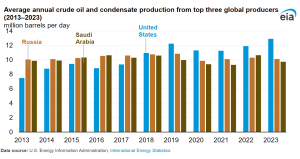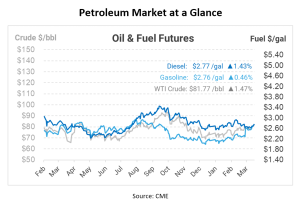
The United States Leads the World in Crude Oil Production
In the intricate web of global energy dynamics, the United States has emerged as a global powerhouse, particularly in the domain of crude oil. Recent data from the US Energy Information Administration (EIA) reveals a remarkable trend: The United States has produced more crude oil than any other country for the past six consecutive years. This achievement not only underscores the nation’s formidable energy capabilities but also signals a significant shift in the dynamics of global oil production.
According to the EIA’s International Energy Statistics, the United States set a new record in 2023 by averaging 12.9 million barrels per day (b/d) of crude oil production, including condensate. This figure surpasses the previous US and global record of 12.3 million b/d, set in 2019. What’s even more impressive is that this record-breaking trend culminated in December 2023, when average monthly U.S. crude oil production soared to over 13.3 million b/d, marking a historic milestone.
The magnitude of the United States’ crude oil production prowess becomes even more apparent compared to other major oil-producing nations. For instance, Saudi Arabia, long regarded as a dominant player in the global oil market, recently scrapped plans to increase its production capacity to 13.0 million b/d by 2027. This decision underscores the formidable lead the United States holds in oil production, with no other country currently capable of matching its output levels.
In 2023, the United States, Russia, and Saudi Arabia collectively accounted for a staggering 40% of global oil production, with their combined output totaling 32.8 million b/d. This triumvirate of oil-producing nations has consistently dominated the global oil landscape since 1971, albeit with fluctuations in each country’s production levels over the decades. Notably, while Canada, Iraq, and China constitute the next three largest oil producers, their combined output in 2023 barely surpassed that of the United States alone, underscoring the nation’s unparalleled contribution to global oil supply.

The resurgence of US crude oil production represents a remarkable turnaround from decades of stagnation and decline. Following a peak of 9.6 million b/d in 1970, US crude oil production experienced a prolonged period of flattening and decline, bottoming out at 5.0 million b/d in 2008. However, since 2009, the adoption of innovative technologies such as hydraulic fracturing and horizontal drilling has fueled a resurgence in domestic oil production, leading to steady growth in output.
The Permian Basin, situated in western Texas and eastern New Mexico, has emerged as a focal point of this production surge, driving significant increases in crude oil and natural gas production in the United States. This recovery has not been without its challenges, however, as evidenced by the downturn in production experienced during the COVID-19 pandemic in 2020 and 2021, when demand and prices plummeted due to economic disruptions.
While the United States has ascended to the pinnacle of global crude oil production, it is essential to contextualize this achievement within the broader landscape of international oil markets. Russia, for example, held the title of the world’s largest crude oil producer in 2017, but its production growth has since lagged behind that of the United States. Despite recent efforts by Russia to curtail production through voluntary cuts, geopolitical factors such as sanctions and the invasion of Ukraine have hindered its ability to impact the global oil supply significantly.
Similarly, Saudi Arabia, another key player in the global oil market, has experienced fluctuations in production levels, with its output declining in 2023 due to OPEC+ cuts and voluntary reductions aimed at offsetting weaker demand growth. Despite possessing substantial reserves, Saudi Arabia’s production capacity remains constrained, further cementing the United States’ position as the undisputed leader in crude oil production.
In conclusion, the United States’ remarkable ascent to the top of the global crude oil production ranks represents a pivotal moment in the history of the energy industry. With innovative technologies driving unprecedented growth in domestic production, the nation has solidified its position as a formidable force in shaping the trajectory of global oil markets. As the world continues to grapple with evolving energy dynamics and geopolitical complexities, the United States’ role as a primary driver of crude oil supply is poised to apply a deep influence on the future of energy security and economic prosperity.

This article is part of Daily Market News & Insights
Tagged:
MARKET CONDITION REPORT - DISCLAIMER
The information contained herein is derived from sources believed to be reliable; however, this information is not guaranteed as to its accuracy or completeness. Furthermore, no responsibility is assumed for use of this material and no express or implied warranties or guarantees are made. This material and any view or comment expressed herein are provided for informational purposes only and should not be construed in any way as an inducement or recommendation to buy or sell products, commodity futures or options contracts.





